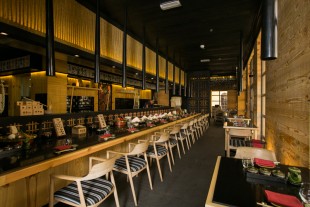

Design case study: Inakaya

The worlds of design and food come together at Inakaya, a Japanese robatayaki restaurant located in the Ritz-Carlton Abu Dhabi across from the iconic Sheikh Zayed Grand Mosque and designed by Dubai-based Stickman Design.
A large theatrical show kitchen with huge robata grills and fresh ingredients on display make for a contemporary and slick interior that respects the traditional nature of Japanese cuisine.
The first Inakaya restaurant opened its doors in the heart of the Roppongi district of Tokyo, Japan, in 1970. The restaurant then expanded by opening a branch in Manhattan, New York.
For a renowned brand, the restaurant design needed to meet the high expectations of diners and be tailored to showcase the outlet’s offerings. The client brief was to create a stand-alone Japanese restaurant in line with the brand concept and, given the cuisine and the style of service, it needed to give the feel of an authentic Japanese restaurant.
“Abu Dhabi National Hotels wanted to bring the well-renowned brand of Inakaya NY and Tokyo, known for its high expectations, to the Ritz Carlton Hotel, Abu Dhabi.
"The design features a live show kitchen set behind its iconic long dining counter where guests receive their dish on a long timber paddle handed to them by the chef himself — another lovely Inakaya signature,” explains Stickman co-founder and director Marcos Cain.
Cain believes that having an authentic Japanese robata grill in the heart of Abu Dhabi was a strong enough concept to draw people in, commenting: “All the design had to do was to create an atmosphere to match the mouth-watering food served. The design of the outlet was created with an inviting, interesting yet simple atmosphere to match the delicious options available on the menu.”
To do so, the overall palette was composed of only three main finishes: the black stained oak, pine wood cladding and slate-inspired porcelain flooring. Upon entering, guests are greeted by an up-lit Samurai warrior framed by black-stained timber screens.
“Subtle movement is created overhead by the hanging folded paper feature in the ceiling inspired by the Omikuji tree — a tradition originating from Shinto shrines and Buddhist temples in Japan,” reveals Cain.
Article continues on next page
A signature feature of Inakaya is a long dining counter, where fresh ingredients are cooked on an open flame in front of an audience, so the guests can enjoy be a part of the overall cooking experience.
One of the design challenges the team faced was the limitation of the front-of-house space; the kitchen demanded a large portion of the space, leaving a limited capacity of 42 seats indoors. Stickman proposed building a glasshouse to increase the seat count by 54 and, in turn, generate more revenue.
“Traditionally you aim for more restaurant than kitchen. Being a destination restaurant, however, the kitchen demanded a 70/30 ratio — far from the industry norm,” shares Cain.
“We proposed a sleek glasshouse to increase the seat count. The design, MEP (mechanical, electrical and plumbing) and acoustic teams all had to work together to find clever ways to work around the services, ceiling drops and sound travel without compromising the overall design of the restaurant,” he continues.
There is a private dining room for guests who prefer a more intimate dining experience. This room features sliding screen doors that can open the room up if necessary, a tiger graphic etched in timber as the backdrop and an overhead feature of 2,000 sake bottles hanging from the ceiling.
Guests who dine outdoors or within the temperature controlled glasshouse have unrestricted views of the creek.
“Most of the design was custom-made for the space, however, the outdoor furniture from Kettal could not suit it more. Like the restaurant design it’s sharp, elegant and simple,” comments Cain.
“We pride ourselves on being 100% bespoke. We tailor everything specifically for each project without a cookie cutter design in sight — something a client expects when they come to us.”
On the subject of how hospitality design has changed over the years, Cain says that the F&B industry is evolving to suit the new target market of millennials.
“The previous generations were all about luxury and grandeur but this one is less interested in pomp and more interested in what’s casual, cutting-edge and efficient.”
Click here to see more photos of Inakaya in the April issue of Caterer Middle East.